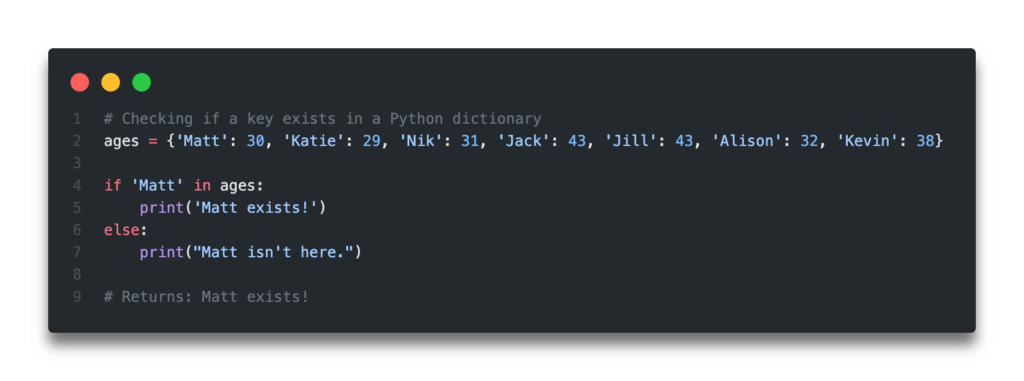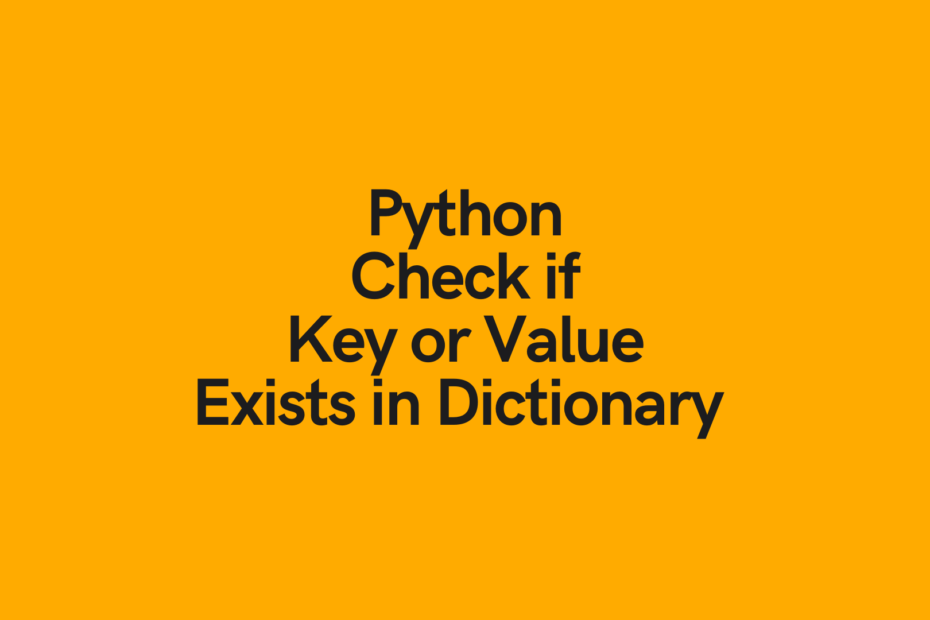In this tutorial, you’ll learn how to use Python to check if a key exists in a dictionary. You’ll also learn how to check if a value exists in a dictionary. You’ll learn how to do this using the in operator, the .get() method, the has_key() function, and the .keys() and .values() methods.
Knowing how to work with Python dictionaries is an important skill. This can be especially helpful when working with web APIs that return JSON data.
While we can easily index a dictionary, if a key doesn’t exist, a KeyError will be thrown. This will cause some significant problems in your program, unless these errors are handled.
A much more safe alternative to using dictionary indexing, is to first check if a given key exists in a dictionary. Let’s get started learning!
The Quick Answer: Use in to see if a key exists

Table of Contents
What is a Python Dictionary?
Dictionaries in Python are one of the main, built-in data structures. They consist of key:value pairs that make finding an items value easy, if you know their corresponding key. One of the unique attributes of a dictionary is that keys must be unique, but that values can be duplicated.
Let’s take a look at how dictionaries look in Python. They’re created using {} curly brackets and the key:value pairs are separated by commas.
Let’s create a dictionary called ages, which, well, contains the ages of different people:
ages = {
'Matt': 30,
'Katie': 29,
'Nik': 31,
'Jack': 43,
'Alison': 32,
'Kevin': 38
}One way that you’re often taught to access a dictionary value is to use indexing via the [] square bracket accessing. In the next section, you’ll see how dictionary indexing works and why it’s not always the best option. Following that, you’ll learn different methods of ensuring that a key exists.
The Problem with Indexing a Python Dictionary
Indexing a dictionary is an easy way of getting a dictionary key’s value – if the given key exists in the dictionary. Let’s take a look at how dictionary indexing works. We’ll use dictionary indexing to get the value for the key Nik from our dictionary ages:
>>> ages = {'Matt': 30, 'Katie': 29, 'Nik': 31, 'Jack': 43, 'Alison': 32, 'Kevin': 38}
>>> print(ages['Nik'])
31We can see here that this worked beautifully. That being said, let’s see if we try to get the value for the key Jill, which doesn’t exist in the dictionary:
>>> ages = {'Matt': 30, 'Katie': 29, 'Nik': 31, 'Jack': 43, 'Alison': 32, 'Kevin': 38}
>>> print(ages['Jill'])
KeyError: 'Jill'We can see here, that if we try to access a dictionary’s value for a key that doesn’t exist, that a KeyError is thrown. This has some huge implications for your code. Unless the error is explicitly handled, the program will fail. One way to avoid a KeyError is to ensure that a key actually exists in a Python dictionary.
That’s exactly what you’ll learn in the next few sections. Let’s get started!
Use Python to Check if a Key Exists: Python keys Method
Python dictionary come with a built-in method that allows us to generate a list-like object that contains all the keys in a dictionary. Conveniently, this is named the .keys() method.
Printing out dict.keys() looks like this:
print(ages.keys())
# Returns: dict_keys(['Matt', 'Katie', 'Nik', 'Jack', 'Alison', 'Kevin'])We can see how that looks like a little bit like a list. We can now check if a key exists in that list-like object!
Let’s see how we can use the .keys() method to see if a key exists in a dictionary. Let’s use this method to see if a key exists:
# Check if a key exists in a Python dictionary by checking all keys
ages = {'Matt': 30, 'Katie': 29, 'Nik': 31, 'Jack': 43, 'Alison': 32, 'Kevin': 38}
some_key = 'James'
if some_key in ages.keys():
print('Key exists')
else:
print('Key doesn\'t exist')
# Returns Key doesn't existWe can see here that we check whether or not a provided key, some_key, exists in the keys of our dictionary. In this case, the key didn’t exist and the program printed out Key doesn't exist.
In the next section, you’ll learn how to simplify this even further!
Use Python to Check if a Key Exists: Python in Operator
The method above works well, but we can simplify checking if a given key exists in a Python dictionary even further. We can actually omit the .keys() method entirely, and using the in operator will scan all keys in a dictionary.
Let’s see how this works in practise:
ages = {'Matt': 30, 'Katie': 29, 'Nik': 31, 'Jack': 43, 'Alison': 32, 'Kevin': 38}
some_key = 'Nik'
if some_key in ages:
print('Key exists')
else:
print('Key doesn\'t exist')
# Returns: Key existsWe can see here that our method actually looks very similar to the above, but we’ve been able to strip out the .keys() method entirely! This actually helps the code read a bit more plain-language.
in the next section, you’ll learn how to actually retrieve a key’s value, even if a key doesn’t exist!
Check out some other Python tutorials on datagy, including our complete guide to styling Pandas and our comprehensive overview of Pivot Tables in Pandas!
Use the .get Method to Check if a Key Exists in a Python Dictionary
Working with dictionaries in Python generally involves getting a key’s value – not just checking if it exists. You learned earlier that simply indexing the dictionary will throw a KeyError if a key doesn’t exist. How can we do this safely, without breaking out program?
The answer to this, is to use the Python .get() method. The .get() method will simply return None if a key doesn’t exist. Let’s try this out:
ages = {'Matt': 30, 'Katie': 29, 'Nik': 31, 'Jack': 43, 'Alison': 32, 'Kevin': 38}
print(ages.get('Jack'))
print(ages.get('Jill'))
# Returns:
# 43
# NoneWe can see here that when the .get() method is applied to return a key that exists, that key’s value is correctly returned. When a key doesn’t exist, the program continues to run, but it returns None.
What is particularly helpful about the Python .get() method, is that it allows us to return a value, even if a key doesn’t exist.
Say we wanted our program to notify us that a key didn’t exist. We could ask the .get() method to return “Key doesn’t exist!”.
Let’s see how we can do this:
ages = {'Matt': 30, 'Katie': 29, 'Nik': 31, 'Jack': 43, 'Alison': 32, 'Kevin': 38}
print(ages.get('Jill', "The key doesn't exist"))
# Returns: "The key doesn't exist!"The .get() method is a great and safe way to see if a key exists in a Python dictionary. Now, let’s learn to see whether or not a given value exists in a Python dictionary.
Check if a Value Exists in a Python Dictionary Using .values()
Similar to the Python dictionary .keys() method, dictionaries have a corresponding .values() method, which returns a list-like object for all the values in a dictionary.
Let’s see how we can access all of a dictionary’s values:
ages = {'Matt': 30, 'Katie': 29, 'Nik': 31, 'Jack': 43, 'Alison': 32, 'Kevin': 38}
print(ages.values())
#Returns: dict_values([30, 29, 31, 43, 32, 38])We can use this to see whether or not a value exists. Say we wanted to know if the age 27 existed in our dictionary, we could write the following:
ages = {'Matt': 30, 'Katie': 29, 'Nik': 31, 'Jack': 43, 'Alison': 32, 'Kevin': 38}
some_age = 27
if some_age in ages.values():
print('Age exists!')
else:
print("Age doesn't exist!")
# Returns: Age doesn't exist!Now, what if we wanted to return the key or keys for a given value. We can safely do this using a list comprehension, which will have three permutations:
- Be an empty list, if the value doesn’t exist,
- Have one item, if the value exists once
- Have more than one item, if the value exists more than once
Let’s use a slightly modified dictionary to see this in action:
# Getting all keys of a certain value in a Python dictionary
ages = {'Matt': 30, 'Katie': 29, 'Nik': 31, 'Jack': 43, 'Jill': 43, 'Alison': 32, 'Kevin': 38}
value_43 = [key for key, value in ages.items() if value == 43]
print(value_43)
# Returns: ['Jack', 'Jill']We’ve created a list comprehension that adds each key, if the value of that key is equal to 43.
What are Python List Comprehensions? To learn more about list comprehensions, check out my comprehensive tutorial here and my in-depth video below!
Conclusion
In this post, you learned how to check if a key exists in a Python dictionary. You learned how to do this with the .keys() method, the in operator, and the .get() method. You also learned how to see if a given value exists in a Python dictionary and how to get that values’ key(s).
To learn more about dictionaries in Python, check out the official documentation here.


Pingback: 7 Ways to Sample Data in Pandas • datagy
Pingback: Python: Reverse a List (6 Easy Ways) • datagy
Pingback: Python: Remove Duplicates From a List (7 Ways) • datagy
Pingback: Python: Convert Degrees to Radians (and Radians to Degrees) • datagy
Pingback: Pandas Rank Function: Rank Dataframe Data (SQL row_number Equivalent) • datagy
Pingback: Python IndexError: List Index Out of Range Error Explained • datagy
Pingback: Python Merge Dictionaries - Combine Dictionaries (7 Ways) • datagy
Pingback: Python: Sort a Dictionary by Values • datagy